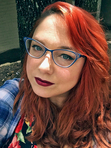Show Me Your Notebook! A glimpse into the (paper) brains of real, live authors.
I’m always talking about the value of paper notebooks as writers. Not everyone uses them, but a lot of us do. And most of us use them in different ways. A few weeks ago I shared my notebooks with you, but I thought it would be interesting to see how other authors put pen to paper. I asked around to see if I could get a few authors to share a page or two and here’s what I found:
From Bryony Pearce, author of ANGEL’S FURY and THE WEIGHT OF SOULS:
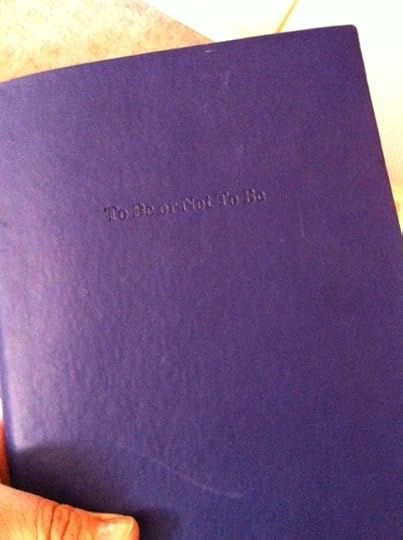
One of Bryony Pearce’s notebooks.
I often don’t feel like a real writer. I never have a pen, I’m always struggling to find paper, or a notebook. I imagine that a ‘real writer’ would have a special silver ‘book signing pen’ with them at all times and that in their back pocket they would have a leather bound notebook which would contain, in a very neat hand, all of their incisive observations about life.
In fact I do have a number of gorgeous leather bound notebooks (here is one).
But here is my confession. I find them all too nice to write in.
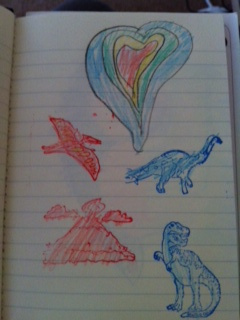
Illustrations from Bryony’s kids.
I haven’t yet come up with a single sentence that I feel is ‘good enough’ to go in my gorgeous leather bound books. The simple loveliness of these empty pages is just too intimidating. I cannot use them for my everyday ramblings – thoughts on books, observations, lists for camping and Sainsburys, things to do lists (of which I have a great number), ideas for birthday presents and so on.
So my gorgeous leather notebooks honestly, remain untouched.
I have a ‘lower grade’ of notebook, which I consider ‘writable in’. However, my daughter and son keep finding these books and they are filled with things like this; they have also become unusable, if not equally precious.
So what I really use to write in are very small paper bound notebooks. I get them from TK Maxx. They fit in my pocket or handbag and they are scrappy enough for my scrappy thoughts; appropriate notebooks for a busy mum who is self-conscious about her ramblings, unwilling to make more out of them than is necessary, not wanting to dress them up in leather.
In the page below I have been trying to work out the genetics behind Taylor’s curse.
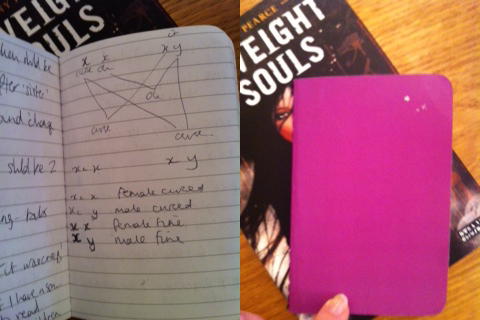
Bryony’s WEIGHT OF SOULS notebook.
From Maureen McGowan, author of DEVIANTS and COMPLIANCE:
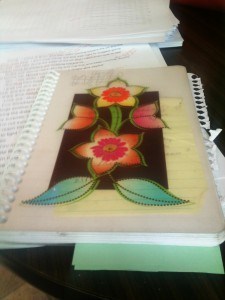
The cover of one of Maureen McGowan’s recent notebooks.
My office is full of notebooks. Notebooks with story ideas. Notebooks with handwritten scenes. Notebooks with scribbled notes from writers’ workshops or critique group feedback. Here is a photo of my current notebooks, with real pressed flowers on (in?) the cover.
I wish I could say I was organized and able to immediately put my fingers on any of these notebooks when desired, but alas, I cannot.
When I’m working on a book, I often scribble notes and ideas in a notebook. I draw maps of scenes, trace through plot lines or sketch out character arcs, if I’m confused about motivations.
And sometimes just putting pen to paper, versus fingers to keyboard, helps get the creative juices flowing. Even if the juice is often messy.
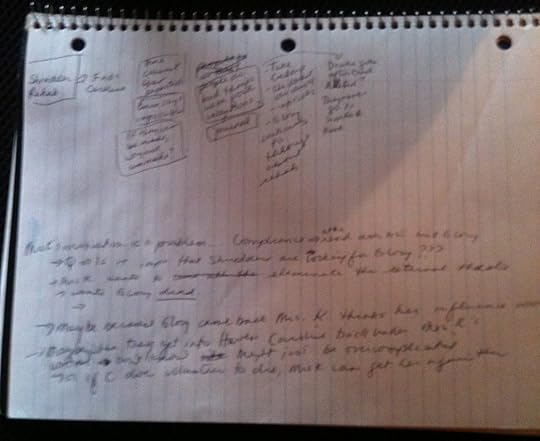
Some of Maureen’s notes.
From Margo Sorensen, author of ISLAND DANGER and TIME OF HONOR:
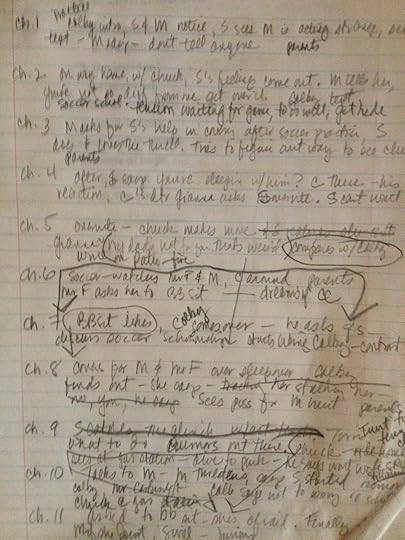
Margo Sorensen’s outline. (Click to enlarge.)
This draft of my latest YA chapter outline (PLAYING WITH FIRE) is from my author’s notebook, and I do this only after I’ve sketched out the characters, asked plenty of “what if?” questions, and filled out an awesome “fiction outline” courtesy of YA author Mary Casanova. Notice that I never erase anything, but just cross out the words; someone suggested that years ago, just in case I want to use those “golden words” (not!) again. When I put it on the computer, I keep an “outtakes” file for those “digital cross-outs.” In the beginning stages, there’s something about the synergy of pencil and paper in my author’s notebook that keeps the creativity going!
From Colleen Conrad:
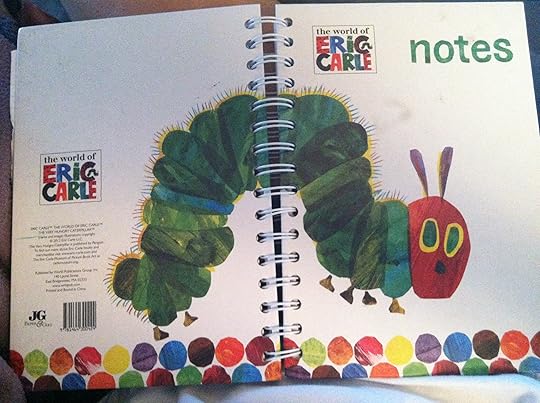
The cover of Colleen’s most recent journal.
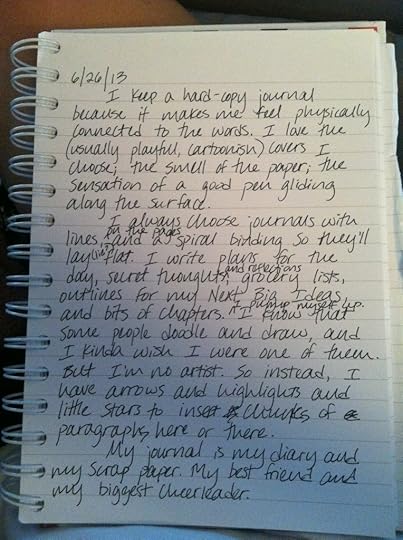
Colleen Conrad chose to share a page where she actually reflects on why and how she uses her journal.
From Elissa Janine Hoole, author of KISS THE MORNING STAR and SOMETIMES NEVER, SOMETIMES ALWAYS:
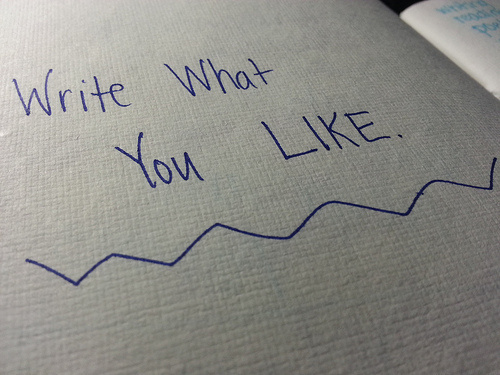
A page from Elissa Janine Hoole’s journal.
This picture is from my favorite journal, my favorite part of it. It says Write What You Like, obviously, and then it’s followed by a list of things I’m interested in, things I like, things I find fascinating. I keep adding to it so it grows and grows, and it inspires the kinds of stories and themes I end up writing about in my books!
From Lesléa Newman, author of OCTOBER MOURNING: A SONG FOR MATTHEW SHEPARD:
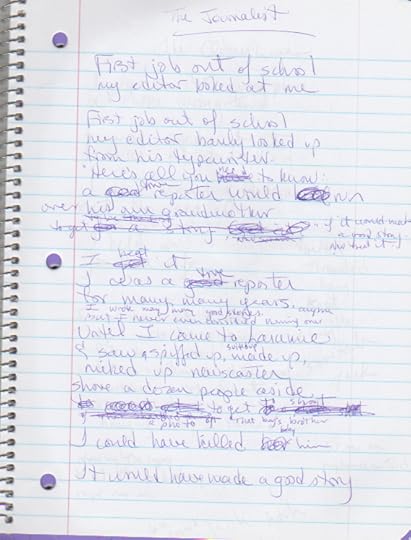
From Lesléa’s notebook.
I have written with a BIC pen and spiral notebook ever since I was in high school. The feeling of a pen in my hand is different than the feeling of my hands on a keyboard. Staring at a blank piece of paper with all those empty lines, blue as horizons, stirs something in me that cannot be duplicated by staring at a computer screen. Everything I have ever written has been born in a notebook.
This is a handwritten draft of “The Journalist” from OCTOBER MOURNING: A SONG FOR MATTHEW SHEPARD.
Fellow writers: What do YOUR notebooks look like? I’d love to see some pics in the comments!







